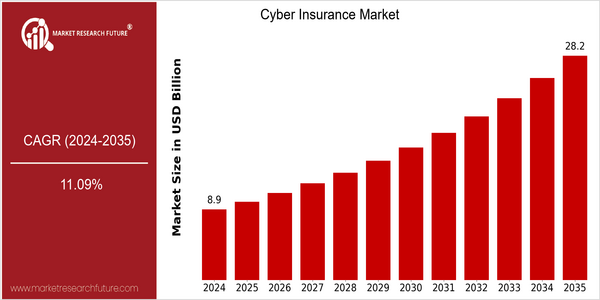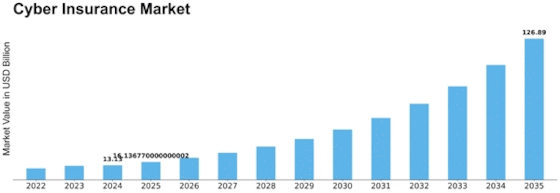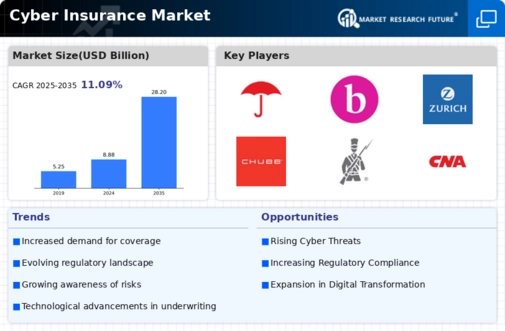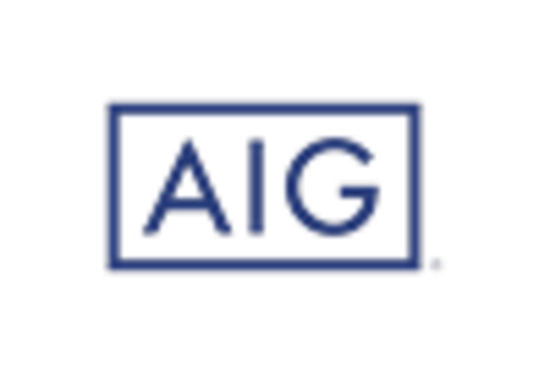-
EXECUTIVE SUMMARY
-
Market Overview
-
Key Findings
-
Market Segmentation
-
Competitive Landscape
-
Challenges and Opportunities
-
Future Outlook
-
MARKET INTRODUCTION
-
Definition
-
Scope of the study
- Research Objective
- Assumption
- Limitations
-
RESEARCH METHODOLOGY
-
Overview
-
Data Mining
-
Secondary Research
-
Primary Research
- Primary Interviews and Information Gathering Process
- Breakdown of Primary Respondents
-
Forecasting Model
-
Market Size Estimation
- Bottom-Up Approach
- Top-Down Approach
-
Data Triangulation
-
Validation
-
MARKET DYNAMICS
-
Overview
-
Drivers
-
Restraints
-
Opportunities
-
MARKET FACTOR ANALYSIS
-
Value chain Analysis
-
Porter's Five Forces Analysis
- Bargaining Power of Suppliers
- Bargaining Power of Buyers
- Threat of New Entrants
- Threat of Substitutes
- Intensity of Rivalry
-
COVID-19 Impact Analysis
- Market Impact Analysis
- Regional Impact
- Opportunity and Threat Analysis
-
CYBER INSURANCE MARKET, BY COVERAGE TYPE (USD BILLION)
-
Network Security Liability
-
Data Breach Response
-
Business Interruption
-
Privacy Liability
-
CYBER INSURANCE MARKET, BY DEPLOYMENT MODE (USD BILLION)
-
Cloud-Based
-
On-Premises
-
CYBER INSURANCE MARKET, BY APPLICATION (USD BILLION)
-
Financial Services
-
Healthcare
-
Retail
-
Manufacturing
-
CYBER INSURANCE MARKET, BY ORGANIZATION SIZE (USD BILLION)
-
Small Enterprises
-
Medium Enterprises
-
Large Enterprises
-
CYBER INSURANCE MARKET, BY REGIONAL (USD BILLION)
-
North America
- US
- Canada
-
Europe
- Germany
- UK
- France
- Russia
- Italy
- Spain
- Rest of Europe
-
APAC
- China
- India
- Japan
- South Korea
- Malaysia
- Thailand
- Indonesia
- Rest of APAC
-
South America
- Brazil
- Mexico
- Argentina
- Rest of South America
-
MEA
- GCC Countries
- South Africa
- Rest of MEA
-
COMPETITIVE LANDSCAPE
-
Overview
-
Competitive Analysis
-
Market share Analysis
-
Major Growth Strategy in the Cyber Insurance Market
-
Competitive Benchmarking
-
Leading Players in Terms of Number of Developments in the Cyber Insurance Market
-
Key developments and growth strategies
- New Product Launch/Service Deployment
- Merger & Acquisitions
- Joint Ventures
-
Major Players Financial Matrix
- Sales and Operating Income
- Major Players R&D Expenditure. 2023
-
COMPANY PROFILES
-
CNA Financial
- Financial Overview
- Products Offered
- Key Developments
- SWOT Analysis
- Key Strategies
-
Beazley
- Financial Overview
- Products Offered
- Key Developments
- SWOT Analysis
- Key Strategies
-
Marsh McLennan
- Financial Overview
- Products Offered
- Key Developments
- SWOT Analysis
- Key Strategies
-
Scor
- Financial Overview
- Products Offered
- Key Developments
- SWOT Analysis
- Key Strategies
-
Liberty Mutual
- Financial Overview
- Products Offered
- Key Developments
- SWOT Analysis
- Key Strategies
-
Lloyd's of London
- Financial Overview
- Products Offered
- Key Developments
- SWOT Analysis
- Key Strategies
-
Hiscox
- Financial Overview
- Products Offered
- Key Developments
- SWOT Analysis
- Key Strategies
-
AIG
- Financial Overview
- Products Offered
- Key Developments
- SWOT Analysis
- Key Strategies
-
Sompo International
- Financial Overview
- Products Offered
- Key Developments
- SWOT Analysis
- Key Strategies
-
Berkshire Hathaway
- Financial Overview
- Products Offered
- Key Developments
- SWOT Analysis
- Key Strategies
-
Allianz
- Financial Overview
- Products Offered
- Key Developments
- SWOT Analysis
- Key Strategies
-
Zurich Insurance
- Financial Overview
- Products Offered
- Key Developments
- SWOT Analysis
- Key Strategies
-
Travelers
- Financial Overview
- Products Offered
- Key Developments
- SWOT Analysis
- Key Strategies
-
Chubb
- Financial Overview
- Products Offered
- Key Developments
- SWOT Analysis
- Key Strategies
-
AXA
- Financial Overview
- Products Offered
- Key Developments
- SWOT Analysis
- Key Strategies
-
APPENDIX
-
References
-
Related Reports
-
LIST OF TABLES
-
LIST OF ASSUMPTIONS
-
NORTH AMERICA CYBER INSURANCE MARKET SIZE ESTIMATES & FORECAST, BY COVERAGE TYPE, 2019-2035 (USD BILLIONS)
-
NORTH AMERICA CYBER INSURANCE MARKET SIZE ESTIMATES & FORECAST, BY DEPLOYMENT MODE, 2019-2035 (USD BILLIONS)
-
NORTH AMERICA CYBER INSURANCE MARKET SIZE ESTIMATES & FORECAST, BY APPLICATION, 2019-2035 (USD BILLIONS)
-
NORTH AMERICA CYBER INSURANCE MARKET SIZE ESTIMATES & FORECAST, BY ORGANIZATION SIZE, 2019-2035 (USD BILLIONS)
-
NORTH AMERICA CYBER INSURANCE MARKET SIZE ESTIMATES & FORECAST, BY REGIONAL, 2019-2035 (USD BILLIONS)
-
US CYBER INSURANCE MARKET SIZE ESTIMATES & FORECAST, BY COVERAGE TYPE, 2019-2035 (USD BILLIONS)
-
US CYBER INSURANCE MARKET SIZE ESTIMATES & FORECAST, BY DEPLOYMENT MODE, 2019-2035 (USD BILLIONS)
-
US CYBER INSURANCE MARKET SIZE ESTIMATES & FORECAST, BY APPLICATION, 2019-2035 (USD BILLIONS)
-
US CYBER INSURANCE MARKET SIZE ESTIMATES & FORECAST, BY ORGANIZATION SIZE, 2019-2035 (USD BILLIONS)
-
US CYBER INSURANCE MARKET SIZE ESTIMATES & FORECAST, BY REGIONAL, 2019-2035 (USD BILLIONS)
-
CANADA CYBER INSURANCE MARKET SIZE ESTIMATES & FORECAST, BY COVERAGE TYPE, 2019-2035 (USD BILLIONS)
-
CANADA CYBER INSURANCE MARKET SIZE ESTIMATES & FORECAST, BY DEPLOYMENT MODE, 2019-2035 (USD BILLIONS)
-
CANADA CYBER INSURANCE MARKET SIZE ESTIMATES & FORECAST, BY APPLICATION, 2019-2035 (USD BILLIONS)
-
CANADA CYBER INSURANCE MARKET SIZE ESTIMATES & FORECAST, BY ORGANIZATION SIZE, 2019-2035 (USD BILLIONS)
-
CANADA CYBER INSURANCE MARKET SIZE ESTIMATES & FORECAST, BY REGIONAL, 2019-2035 (USD BILLIONS)
-
EUROPE CYBER INSURANCE MARKET SIZE ESTIMATES & FORECAST, BY COVERAGE TYPE, 2019-2035 (USD BILLIONS)
-
EUROPE CYBER INSURANCE MARKET SIZE ESTIMATES & FORECAST, BY DEPLOYMENT MODE, 2019-2035 (USD BILLIONS)
-
EUROPE CYBER INSURANCE MARKET SIZE ESTIMATES & FORECAST, BY APPLICATION, 2019-2035 (USD BILLIONS)
-
EUROPE CYBER INSURANCE MARKET SIZE ESTIMATES & FORECAST, BY ORGANIZATION SIZE, 2019-2035 (USD BILLIONS)
-
EUROPE CYBER INSURANCE MARKET SIZE ESTIMATES & FORECAST, BY REGIONAL, 2019-2035 (USD BILLIONS)
-
GERMANY CYBER INSURANCE MARKET SIZE ESTIMATES & FORECAST, BY COVERAGE TYPE, 2019-2035 (USD BILLIONS)
-
GERMANY CYBER INSURANCE MARKET SIZE ESTIMATES & FORECAST, BY DEPLOYMENT MODE, 2019-2035 (USD BILLIONS)
-
GERMANY CYBER INSURANCE MARKET SIZE ESTIMATES & FORECAST, BY APPLICATION, 2019-2035 (USD BILLIONS)
-
GERMANY CYBER INSURANCE MARKET SIZE ESTIMATES & FORECAST, BY ORGANIZATION SIZE, 2019-2035 (USD BILLIONS)
-
GERMANY CYBER INSURANCE MARKET SIZE ESTIMATES & FORECAST, BY REGIONAL, 2019-2035 (USD BILLIONS)
-
UK CYBER INSURANCE MARKET SIZE ESTIMATES & FORECAST, BY COVERAGE TYPE, 2019-2035 (USD BILLIONS)
-
UK CYBER INSURANCE MARKET SIZE ESTIMATES & FORECAST, BY DEPLOYMENT MODE, 2019-2035 (USD BILLIONS)
-
UK CYBER INSURANCE MARKET SIZE ESTIMATES & FORECAST, BY APPLICATION, 2019-2035 (USD BILLIONS)
-
UK CYBER INSURANCE MARKET SIZE ESTIMATES & FORECAST, BY ORGANIZATION SIZE, 2019-2035 (USD BILLIONS)
-
UK CYBER INSURANCE MARKET SIZE ESTIMATES & FORECAST, BY REGIONAL, 2019-2035 (USD BILLIONS)
-
FRANCE CYBER INSURANCE MARKET SIZE ESTIMATES & FORECAST, BY COVERAGE TYPE, 2019-2035 (USD BILLIONS)
-
FRANCE CYBER INSURANCE MARKET SIZE ESTIMATES & FORECAST, BY DEPLOYMENT MODE, 2019-2035 (USD BILLIONS)
-
FRANCE CYBER INSURANCE MARKET SIZE ESTIMATES & FORECAST, BY APPLICATION, 2019-2035 (USD BILLIONS)
-
FRANCE CYBER INSURANCE MARKET SIZE ESTIMATES & FORECAST, BY ORGANIZATION SIZE, 2019-2035 (USD BILLIONS)
-
FRANCE CYBER INSURANCE MARKET SIZE ESTIMATES & FORECAST, BY REGIONAL, 2019-2035 (USD BILLIONS)
-
RUSSIA CYBER INSURANCE MARKET SIZE ESTIMATES & FORECAST, BY COVERAGE TYPE, 2019-2035 (USD BILLIONS)
-
RUSSIA CYBER INSURANCE MARKET SIZE ESTIMATES & FORECAST, BY DEPLOYMENT MODE, 2019-2035 (USD BILLIONS)
-
RUSSIA CYBER INSURANCE MARKET SIZE ESTIMATES & FORECAST, BY APPLICATION, 2019-2035 (USD BILLIONS)
-
RUSSIA CYBER INSURANCE MARKET SIZE ESTIMATES & FORECAST, BY ORGANIZATION SIZE, 2019-2035 (USD BILLIONS)
-
RUSSIA CYBER INSURANCE MARKET SIZE ESTIMATES & FORECAST, BY REGIONAL, 2019-2035 (USD BILLIONS)
-
ITALY CYBER INSURANCE MARKET SIZE ESTIMATES & FORECAST, BY COVERAGE TYPE, 2019-2035 (USD BILLIONS)
-
ITALY CYBER INSURANCE MARKET SIZE ESTIMATES & FORECAST, BY DEPLOYMENT MODE, 2019-2035 (USD BILLIONS)
-
ITALY CYBER INSURANCE MARKET SIZE ESTIMATES & FORECAST, BY APPLICATION, 2019-2035 (USD BILLIONS)
-
ITALY CYBER INSURANCE MARKET SIZE ESTIMATES & FORECAST, BY ORGANIZATION SIZE, 2019-2035 (USD BILLIONS)
-
ITALY CYBER INSURANCE MARKET SIZE ESTIMATES & FORECAST, BY REGIONAL, 2019-2035 (USD BILLIONS)
-
SPAIN CYBER INSURANCE MARKET SIZE ESTIMATES & FORECAST, BY COVERAGE TYPE, 2019-2035 (USD BILLIONS)
-
SPAIN CYBER INSURANCE MARKET SIZE ESTIMATES & FORECAST, BY DEPLOYMENT MODE, 2019-2035 (USD BILLIONS)
-
SPAIN CYBER INSURANCE MARKET SIZE ESTIMATES & FORECAST, BY APPLICATION, 2019-2035 (USD BILLIONS)
-
SPAIN CYBER INSURANCE MARKET SIZE ESTIMATES & FORECAST, BY ORGANIZATION SIZE, 2019-2035 (USD BILLIONS)
-
SPAIN CYBER INSURANCE MARKET SIZE ESTIMATES & FORECAST, BY REGIONAL, 2019-2035 (USD BILLIONS)
-
REST OF EUROPE CYBER INSURANCE MARKET SIZE ESTIMATES & FORECAST, BY COVERAGE TYPE, 2019-2035 (USD BILLIONS)
-
REST OF EUROPE CYBER INSURANCE MARKET SIZE ESTIMATES & FORECAST, BY DEPLOYMENT MODE, 2019-2035 (USD BILLIONS)
-
REST OF EUROPE CYBER INSURANCE MARKET SIZE ESTIMATES & FORECAST, BY APPLICATION, 2019-2035 (USD BILLIONS)
-
REST OF EUROPE CYBER INSURANCE MARKET SIZE ESTIMATES & FORECAST, BY ORGANIZATION SIZE, 2019-2035 (USD BILLIONS)
-
REST OF EUROPE CYBER INSURANCE MARKET SIZE ESTIMATES & FORECAST, BY REGIONAL, 2019-2035 (USD BILLIONS)
-
APAC CYBER INSURANCE MARKET SIZE ESTIMATES & FORECAST, BY COVERAGE TYPE, 2019-2035 (USD BILLIONS)
-
APAC CYBER INSURANCE MARKET SIZE ESTIMATES & FORECAST, BY DEPLOYMENT MODE, 2019-2035 (USD BILLIONS)
-
APAC CYBER INSURANCE MARKET SIZE ESTIMATES & FORECAST, BY APPLICATION, 2019-2035 (USD BILLIONS)
-
APAC CYBER INSURANCE MARKET SIZE ESTIMATES & FORECAST, BY ORGANIZATION SIZE, 2019-2035 (USD BILLIONS)
-
APAC CYBER INSURANCE MARKET SIZE ESTIMATES & FORECAST, BY REGIONAL, 2019-2035 (USD BILLIONS)
-
CHINA CYBER INSURANCE MARKET SIZE ESTIMATES & FORECAST, BY COVERAGE TYPE, 2019-2035 (USD BILLIONS)
-
CHINA CYBER INSURANCE MARKET SIZE ESTIMATES & FORECAST, BY DEPLOYMENT MODE, 2019-2035 (USD BILLIONS)
-
CHINA CYBER INSURANCE MARKET SIZE ESTIMATES & FORECAST, BY APPLICATION, 2019-2035 (USD BILLIONS)
-
CHINA CYBER INSURANCE MARKET SIZE ESTIMATES & FORECAST, BY ORGANIZATION SIZE, 2019-2035 (USD BILLIONS)
-
CHINA CYBER INSURANCE MARKET SIZE ESTIMATES & FORECAST, BY REGIONAL, 2019-2035 (USD BILLIONS)
-
INDIA CYBER INSURANCE MARKET SIZE ESTIMATES & FORECAST, BY COVERAGE TYPE, 2019-2035 (USD BILLIONS)
-
INDIA CYBER INSURANCE MARKET SIZE ESTIMATES & FORECAST, BY DEPLOYMENT MODE, 2019-2035 (USD BILLIONS)
-
INDIA CYBER INSURANCE MARKET SIZE ESTIMATES & FORECAST, BY APPLICATION, 2019-2035 (USD BILLIONS)
-
INDIA CYBER INSURANCE MARKET SIZE ESTIMATES & FORECAST, BY ORGANIZATION SIZE, 2019-2035 (USD BILLIONS)
-
INDIA CYBER INSURANCE MARKET SIZE ESTIMATES & FORECAST, BY REGIONAL, 2019-2035 (USD BILLIONS)
-
JAPAN CYBER INSURANCE MARKET SIZE ESTIMATES & FORECAST, BY COVERAGE TYPE, 2019-2035 (USD BILLIONS)
-
JAPAN CYBER INSURANCE MARKET SIZE ESTIMATES & FORECAST, BY DEPLOYMENT MODE, 2019-2035 (USD BILLIONS)
-
JAPAN CYBER INSURANCE MARKET SIZE ESTIMATES & FORECAST, BY APPLICATION, 2019-2035 (USD BILLIONS)
-
JAPAN CYBER INSURANCE MARKET SIZE ESTIMATES & FORECAST, BY ORGANIZATION SIZE, 2019-2035 (USD BILLIONS)
-
JAPAN CYBER INSURANCE MARKET SIZE ESTIMATES & FORECAST, BY REGIONAL, 2019-2035 (USD BILLIONS)
-
SOUTH KOREA CYBER INSURANCE MARKET SIZE ESTIMATES & FORECAST, BY COVERAGE TYPE, 2019-2035 (USD BILLIONS)
-
SOUTH KOREA CYBER INSURANCE MARKET SIZE ESTIMATES & FORECAST, BY DEPLOYMENT MODE, 2019-2035 (USD BILLIONS)
-
SOUTH KOREA CYBER INSURANCE MARKET SIZE ESTIMATES & FORECAST, BY APPLICATION, 2019-2035 (USD BILLIONS)
-
SOUTH KOREA CYBER INSURANCE MARKET SIZE ESTIMATES & FORECAST, BY ORGANIZATION SIZE, 2019-2035 (USD BILLIONS)
-
SOUTH KOREA CYBER INSURANCE MARKET SIZE ESTIMATES & FORECAST, BY REGIONAL, 2019-2035 (USD BILLIONS)
-
MALAYSIA CYBER INSURANCE MARKET SIZE ESTIMATES & FORECAST, BY COVERAGE TYPE, 2019-2035 (USD BILLIONS)
-
MALAYSIA CYBER INSURANCE MARKET SIZE ESTIMATES & FORECAST, BY DEPLOYMENT MODE, 2019-2035 (USD BILLIONS)
-
MALAYSIA CYBER INSURANCE MARKET SIZE ESTIMATES & FORECAST, BY APPLICATION, 2019-2035 (USD BILLIONS)
-
MALAYSIA CYBER INSURANCE MARKET SIZE ESTIMATES & FORECAST, BY ORGANIZATION SIZE, 2019-2035 (USD BILLIONS)
-
MALAYSIA CYBER INSURANCE MARKET SIZE ESTIMATES & FORECAST, BY REGIONAL, 2019-2035 (USD BILLIONS)
-
THAILAND CYBER INSURANCE MARKET SIZE ESTIMATES & FORECAST, BY COVERAGE TYPE, 2019-2035 (USD BILLIONS)
-
THAILAND CYBER INSURANCE MARKET SIZE ESTIMATES & FORECAST, BY DEPLOYMENT MODE, 2019-2035 (USD BILLIONS)
-
THAILAND CYBER INSURANCE MARKET SIZE ESTIMATES & FORECAST, BY APPLICATION, 2019-2035 (USD BILLIONS)
-
THAILAND CYBER INSURANCE MARKET SIZE ESTIMATES & FORECAST, BY ORGANIZATION SIZE, 2019-2035 (USD BILLIONS)
-
THAILAND CYBER INSURANCE MARKET SIZE ESTIMATES & FORECAST, BY REGIONAL, 2019-2035 (USD BILLIONS)
-
INDONESIA CYBER INSURANCE MARKET SIZE ESTIMATES & FORECAST, BY COVERAGE TYPE, 2019-2035 (USD BILLIONS)
-
INDONESIA CYBER INSURANCE MARKET SIZE ESTIMATES & FORECAST, BY DEPLOYMENT MODE, 2019-2035 (USD BILLIONS)
-
INDONESIA CYBER INSURANCE MARKET SIZE ESTIMATES & FORECAST, BY APPLICATION, 2019-2035 (USD BILLIONS)
-
INDONESIA CYBER INSURANCE MARKET SIZE ESTIMATES & FORECAST, BY ORGANIZATION SIZE, 2019-2035 (USD BILLIONS)
-
INDONESIA CYBER INSURANCE MARKET SIZE ESTIMATES & FORECAST, BY REGIONAL, 2019-2035 (USD BILLIONS)
-
REST OF APAC CYBER INSURANCE MARKET SIZE ESTIMATES & FORECAST, BY COVERAGE TYPE, 2019-2035 (USD BILLIONS)
-
REST OF APAC CYBER INSURANCE MARKET SIZE ESTIMATES & FORECAST, BY DEPLOYMENT MODE, 2019-2035 (USD BILLIONS)
-
REST OF APAC CYBER INSURANCE MARKET SIZE ESTIMATES & FORECAST, BY APPLICATION, 2019-2035 (USD BILLIONS)
-
REST OF APAC CYBER INSURANCE MARKET SIZE ESTIMATES & FORECAST, BY ORGANIZATION SIZE, 2019-2035 (USD BILLIONS)
-
REST OF APAC CYBER INSURANCE MARKET SIZE ESTIMATES & FORECAST, BY REGIONAL, 2019-2035 (USD BILLIONS)
-
SOUTH AMERICA CYBER INSURANCE MARKET SIZE ESTIMATES & FORECAST, BY COVERAGE TYPE, 2019-2035 (USD BILLIONS)
-
SOUTH AMERICA CYBER INSURANCE MARKET SIZE ESTIMATES & FORECAST, BY DEPLOYMENT MODE, 2019-2035 (USD BILLIONS)
-
SOUTH AMERICA CYBER INSURANCE MARKET SIZE ESTIMATES & FORECAST, BY APPLICATION, 2019-2035 (USD BILLIONS)
-
SOUTH AMERICA CYBER INSURANCE MARKET SIZE ESTIMATES & FORECAST, BY ORGANIZATION SIZE, 2019-2035 (USD BILLIONS)
-
SOUTH AMERICA CYBER INSURANCE MARKET SIZE ESTIMATES & FORECAST, BY REGIONAL, 2019-2035 (USD BILLIONS)
-
BRAZIL CYBER INSURANCE MARKET SIZE ESTIMATES & FORECAST, BY COVERAGE TYPE, 2019-2035 (USD BILLIONS)
-
BRAZIL CYBER INSURANCE MARKET SIZE ESTIMATES & FORECAST, BY DEPLOYMENT MODE, 2019-2035 (USD BILLIONS)
-
BRAZIL CYBER INSURANCE MARKET SIZE ESTIMATES & FORECAST, BY APPLICATION, 2019-2035 (USD BILLIONS)
-
BRAZIL CYBER INSURANCE MARKET SIZE ESTIMATES & FORECAST, BY ORGANIZATION SIZE, 2019-2035 (USD BILLIONS)
-
BRAZIL CYBER INSURANCE MARKET SIZE ESTIMATES & FORECAST, BY REGIONAL, 2019-2035 (USD BILLIONS)
-
MEXICO CYBER INSURANCE MARKET SIZE ESTIMATES & FORECAST, BY COVERAGE TYPE, 2019-2035 (USD BILLIONS)
-
MEXICO CYBER INSURANCE MARKET SIZE ESTIMATES & FORECAST, BY DEPLOYMENT MODE, 2019-2035 (USD BILLIONS)
-
MEXICO CYBER INSURANCE MARKET SIZE ESTIMATES & FORECAST, BY APPLICATION, 2019-2035 (USD BILLIONS)
-
MEXICO CYBER INSURANCE MARKET SIZE ESTIMATES & FORECAST, BY ORGANIZATION SIZE, 2019-2035 (USD BILLIONS)
-
MEXICO CYBER INSURANCE MARKET SIZE ESTIMATES & FORECAST, BY REGIONAL, 2019-2035 (USD BILLIONS)
-
ARGENTINA CYBER INSURANCE MARKET SIZE ESTIMATES & FORECAST, BY COVERAGE TYPE, 2019-2035 (USD BILLIONS)
-
ARGENTINA CYBER INSURANCE MARKET SIZE ESTIMATES & FORECAST, BY DEPLOYMENT MODE, 2019-2035 (USD BILLIONS)
-
ARGENTINA CYBER INSURANCE MARKET SIZE ESTIMATES & FORECAST, BY APPLICATION, 2019-2035 (USD BILLIONS)
-
ARGENTINA CYBER INSURANCE MARKET SIZE ESTIMATES & FORECAST, BY ORGANIZATION SIZE, 2019-2035 (USD BILLIONS)
-
ARGENTINA CYBER INSURANCE MARKET SIZE ESTIMATES & FORECAST, BY REGIONAL, 2019-2035 (USD BILLIONS)
-
REST OF SOUTH AMERICA CYBER INSURANCE MARKET SIZE ESTIMATES & FORECAST, BY COVERAGE TYPE, 2019-2035 (USD BILLIONS)
-
REST OF SOUTH AMERICA CYBER INSURANCE MARKET SIZE ESTIMATES & FORECAST, BY DEPLOYMENT MODE, 2019-2035 (USD BILLIONS)
-
REST OF SOUTH AMERICA CYBER INSURANCE MARKET SIZE ESTIMATES & FORECAST, BY APPLICATION, 2019-2035 (USD BILLIONS)
-
REST OF SOUTH AMERICA CYBER INSURANCE MARKET SIZE ESTIMATES & FORECAST, BY ORGANIZATION SIZE, 2019-2035 (USD BILLIONS)
-
REST OF SOUTH AMERICA CYBER INSURANCE MARKET SIZE ESTIMATES & FORECAST, BY REGIONAL, 2019-2035 (USD BILLIONS)
-
MEA CYBER INSURANCE MARKET SIZE ESTIMATES & FORECAST, BY COVERAGE TYPE, 2019-2035 (USD BILLIONS)
-
MEA CYBER INSURANCE MARKET SIZE ESTIMATES & FORECAST, BY DEPLOYMENT MODE, 2019-2035 (USD BILLIONS)
-
MEA CYBER INSURANCE MARKET SIZE ESTIMATES & FORECAST, BY APPLICATION, 2019-2035 (USD BILLIONS)
-
MEA CYBER INSURANCE MARKET SIZE ESTIMATES & FORECAST, BY ORGANIZATION SIZE, 2019-2035 (USD BILLIONS)
-
MEA CYBER INSURANCE MARKET SIZE ESTIMATES & FORECAST, BY REGIONAL, 2019-2035 (USD BILLIONS)
-
GCC COUNTRIES CYBER INSURANCE MARKET SIZE ESTIMATES & FORECAST, BY COVERAGE TYPE, 2019-2035 (USD BILLIONS)
-
GCC COUNTRIES CYBER INSURANCE MARKET SIZE ESTIMATES & FORECAST, BY DEPLOYMENT MODE, 2019-2035 (USD BILLIONS)
-
GCC COUNTRIES CYBER INSURANCE MARKET SIZE ESTIMATES & FORECAST, BY APPLICATION, 2019-2035 (USD BILLIONS)
-
GCC COUNTRIES CYBER INSURANCE MARKET SIZE ESTIMATES & FORECAST, BY ORGANIZATION SIZE, 2019-2035 (USD BILLIONS)
-
GCC COUNTRIES CYBER INSURANCE MARKET SIZE ESTIMATES & FORECAST, BY REGIONAL, 2019-2035 (USD BILLIONS)
-
SOUTH AFRICA CYBER INSURANCE MARKET SIZE ESTIMATES & FORECAST, BY COVERAGE TYPE, 2019-2035 (USD BILLIONS)
-
SOUTH AFRICA CYBER INSURANCE MARKET SIZE ESTIMATES & FORECAST, BY DEPLOYMENT MODE, 2019-2035 (USD BILLIONS)
-
SOUTH AFRICA CYBER INSURANCE MARKET SIZE ESTIMATES & FORECAST, BY APPLICATION, 2019-2035 (USD BILLIONS)
-
SOUTH AFRICA CYBER INSURANCE MARKET SIZE ESTIMATES & FORECAST, BY ORGANIZATION SIZE, 2019-2035 (USD BILLIONS)
-
SOUTH AFRICA CYBER INSURANCE MARKET SIZE ESTIMATES & FORECAST, BY REGIONAL, 2019-2035 (USD BILLIONS)
-
REST OF MEA CYBER INSURANCE MARKET SIZE ESTIMATES & FORECAST, BY COVERAGE TYPE, 2019-2035 (USD BILLIONS)
-
REST OF MEA CYBER INSURANCE MARKET SIZE ESTIMATES & FORECAST, BY DEPLOYMENT MODE, 2019-2035 (USD BILLIONS)
-
REST OF MEA CYBER INSURANCE MARKET SIZE ESTIMATES & FORECAST, BY APPLICATION, 2019-2035 (USD BILLIONS)
-
REST OF MEA CYBER INSURANCE MARKET SIZE ESTIMATES & FORECAST, BY ORGANIZATION SIZE, 2019-2035 (USD BILLIONS)
-
REST OF MEA CYBER INSURANCE MARKET SIZE ESTIMATES & FORECAST, BY REGIONAL, 2019-2035 (USD BILLIONS)
-
PRODUCT LAUNCH/PRODUCT DEVELOPMENT/APPROVAL
-
ACQUISITION/PARTNERSHIP
-
LIST OF FIGURES
-
MARKET SYNOPSIS
-
NORTH AMERICA CYBER INSURANCE MARKET ANALYSIS
-
US CYBER INSURANCE MARKET ANALYSIS BY COVERAGE TYPE
-
US CYBER INSURANCE MARKET ANALYSIS BY DEPLOYMENT MODE
-
US CYBER INSURANCE MARKET ANALYSIS BY APPLICATION
-
US CYBER INSURANCE MARKET ANALYSIS BY ORGANIZATION SIZE
-
US CYBER INSURANCE MARKET ANALYSIS BY REGIONAL
-
CANADA CYBER INSURANCE MARKET ANALYSIS BY COVERAGE TYPE
-
CANADA CYBER INSURANCE MARKET ANALYSIS BY DEPLOYMENT MODE
-
CANADA CYBER INSURANCE MARKET ANALYSIS BY APPLICATION
-
CANADA CYBER INSURANCE MARKET ANALYSIS BY ORGANIZATION SIZE
-
CANADA CYBER INSURANCE MARKET ANALYSIS BY REGIONAL
-
EUROPE CYBER INSURANCE MARKET ANALYSIS
-
GERMANY CYBER INSURANCE MARKET ANALYSIS BY COVERAGE TYPE
-
GERMANY CYBER INSURANCE MARKET ANALYSIS BY DEPLOYMENT MODE
-
GERMANY CYBER INSURANCE MARKET ANALYSIS BY APPLICATION
-
GERMANY CYBER INSURANCE MARKET ANALYSIS BY ORGANIZATION SIZE
-
GERMANY CYBER INSURANCE MARKET ANALYSIS BY REGIONAL
-
UK CYBER INSURANCE MARKET ANALYSIS BY COVERAGE TYPE
-
UK CYBER INSURANCE MARKET ANALYSIS BY DEPLOYMENT MODE
-
UK CYBER INSURANCE MARKET ANALYSIS BY APPLICATION
-
UK CYBER INSURANCE MARKET ANALYSIS BY ORGANIZATION SIZE
-
UK CYBER INSURANCE MARKET ANALYSIS BY REGIONAL
-
FRANCE CYBER INSURANCE MARKET ANALYSIS BY COVERAGE TYPE
-
FRANCE CYBER INSURANCE MARKET ANALYSIS BY DEPLOYMENT MODE
-
FRANCE CYBER INSURANCE MARKET ANALYSIS BY APPLICATION
-
FRANCE CYBER INSURANCE MARKET ANALYSIS BY ORGANIZATION SIZE
-
FRANCE CYBER INSURANCE MARKET ANALYSIS BY REGIONAL
-
RUSSIA CYBER INSURANCE MARKET ANALYSIS BY COVERAGE TYPE
-
RUSSIA CYBER INSURANCE MARKET ANALYSIS BY DEPLOYMENT MODE
-
RUSSIA CYBER INSURANCE MARKET ANALYSIS BY APPLICATION
-
RUSSIA CYBER INSURANCE MARKET ANALYSIS BY ORGANIZATION SIZE
-
RUSSIA CYBER INSURANCE MARKET ANALYSIS BY REGIONAL
-
ITALY CYBER INSURANCE MARKET ANALYSIS BY COVERAGE TYPE
-
ITALY CYBER INSURANCE MARKET ANALYSIS BY DEPLOYMENT MODE
-
ITALY CYBER INSURANCE MARKET ANALYSIS BY APPLICATION
-
ITALY CYBER INSURANCE MARKET ANALYSIS BY ORGANIZATION SIZE
-
ITALY CYBER INSURANCE MARKET ANALYSIS BY REGIONAL
-
SPAIN CYBER INSURANCE MARKET ANALYSIS BY COVERAGE TYPE
-
SPAIN CYBER INSURANCE MARKET ANALYSIS BY DEPLOYMENT MODE
-
SPAIN CYBER INSURANCE MARKET ANALYSIS BY APPLICATION
-
SPAIN CYBER INSURANCE MARKET ANALYSIS BY ORGANIZATION SIZE
-
SPAIN CYBER INSURANCE MARKET ANALYSIS BY REGIONAL
-
REST OF EUROPE CYBER INSURANCE MARKET ANALYSIS BY COVERAGE TYPE
-
REST OF EUROPE CYBER INSURANCE MARKET ANALYSIS BY DEPLOYMENT MODE
-
REST OF EUROPE CYBER INSURANCE MARKET ANALYSIS BY APPLICATION
-
REST OF EUROPE CYBER INSURANCE MARKET ANALYSIS BY ORGANIZATION SIZE
-
REST OF EUROPE CYBER INSURANCE MARKET ANALYSIS BY REGIONAL
-
APAC CYBER INSURANCE MARKET ANALYSIS
-
CHINA CYBER INSURANCE MARKET ANALYSIS BY COVERAGE TYPE
-
CHINA CYBER INSURANCE MARKET ANALYSIS BY DEPLOYMENT MODE
-
CHINA CYBER INSURANCE MARKET ANALYSIS BY APPLICATION
-
CHINA CYBER INSURANCE MARKET ANALYSIS BY ORGANIZATION SIZE
-
CHINA CYBER INSURANCE MARKET ANALYSIS BY REGIONAL
-
INDIA CYBER INSURANCE MARKET ANALYSIS BY COVERAGE TYPE
-
INDIA CYBER INSURANCE MARKET ANALYSIS BY DEPLOYMENT MODE
-
INDIA CYBER INSURANCE MARKET ANALYSIS BY APPLICATION
-
INDIA CYBER INSURANCE MARKET ANALYSIS BY ORGANIZATION SIZE
-
INDIA CYBER INSURANCE MARKET ANALYSIS BY REGIONAL
-
JAPAN CYBER INSURANCE MARKET ANALYSIS BY COVERAGE TYPE
-
JAPAN CYBER INSURANCE MARKET ANALYSIS BY DEPLOYMENT MODE
-
JAPAN CYBER INSURANCE MARKET ANALYSIS BY APPLICATION
-
JAPAN CYBER INSURANCE MARKET ANALYSIS BY ORGANIZATION SIZE
-
JAPAN CYBER INSURANCE MARKET ANALYSIS BY REGIONAL
-
SOUTH KOREA CYBER INSURANCE MARKET ANALYSIS BY COVERAGE TYPE
-
SOUTH KOREA CYBER INSURANCE MARKET ANALYSIS BY DEPLOYMENT MODE
-
SOUTH KOREA CYBER INSURANCE MARKET ANALYSIS BY APPLICATION
-
SOUTH KOREA CYBER INSURANCE MARKET ANALYSIS BY ORGANIZATION SIZE
-
SOUTH KOREA CYBER INSURANCE MARKET ANALYSIS BY REGIONAL
-
MALAYSIA CYBER INSURANCE MARKET ANALYSIS BY COVERAGE TYPE
-
MALAYSIA CYBER INSURANCE MARKET ANALYSIS BY DEPLOYMENT MODE
-
MALAYSIA CYBER INSURANCE MARKET ANALYSIS BY APPLICATION
-
MALAYSIA CYBER INSURANCE MARKET ANALYSIS BY ORGANIZATION SIZE
-
MALAYSIA CYBER INSURANCE MARKET ANALYSIS BY REGIONAL
-
THAILAND CYBER INSURANCE MARKET ANALYSIS BY COVERAGE TYPE
-
THAILAND CYBER INSURANCE MARKET ANALYSIS BY DEPLOYMENT MODE
-
THAILAND CYBER INSURANCE MARKET ANALYSIS BY APPLICATION
-
THAILAND CYBER INSURANCE MARKET ANALYSIS BY ORGANIZATION SIZE
-
THAILAND CYBER INSURANCE MARKET ANALYSIS BY REGIONAL
-
INDONESIA CYBER INSURANCE MARKET ANALYSIS BY COVERAGE TYPE
-
INDONESIA CYBER INSURANCE MARKET ANALYSIS BY DEPLOYMENT MODE
-
INDONESIA CYBER INSURANCE MARKET ANALYSIS BY APPLICATION
-
INDONESIA CYBER INSURANCE MARKET ANALYSIS BY ORGANIZATION SIZE
-
INDONESIA CYBER INSURANCE MARKET ANALYSIS BY REGIONAL
-
REST OF APAC CYBER INSURANCE MARKET ANALYSIS BY COVERAGE TYPE
-
REST OF APAC CYBER INSURANCE MARKET ANALYSIS BY DEPLOYMENT MODE
-
REST OF APAC CYBER INSURANCE MARKET ANALYSIS BY APPLICATION
-
REST OF APAC CYBER INSURANCE MARKET ANALYSIS BY ORGANIZATION SIZE
-
REST OF APAC CYBER INSURANCE MARKET ANALYSIS BY REGIONAL
-
SOUTH AMERICA CYBER INSURANCE MARKET ANALYSIS
-
BRAZIL CYBER INSURANCE MARKET ANALYSIS BY COVERAGE TYPE
-
BRAZIL CYBER INSURANCE MARKET ANALYSIS BY DEPLOYMENT MODE
-
BRAZIL CYBER INSURANCE MARKET ANALYSIS BY APPLICATION
-
BRAZIL CYBER INSURANCE MARKET ANALYSIS BY ORGANIZATION SIZE
-
BRAZIL CYBER INSURANCE MARKET ANALYSIS BY REGIONAL
-
MEXICO CYBER INSURANCE MARKET ANALYSIS BY COVERAGE TYPE
-
MEXICO CYBER INSURANCE MARKET ANALYSIS BY DEPLOYMENT MODE
-
MEXICO CYBER INSURANCE MARKET ANALYSIS BY APPLICATION
-
MEXICO CYBER INSURANCE MARKET ANALYSIS BY ORGANIZATION SIZE
-
MEXICO CYBER INSURANCE MARKET ANALYSIS BY REGIONAL
-
ARGENTINA CYBER INSURANCE MARKET ANALYSIS BY COVERAGE TYPE
-
ARGENTINA CYBER INSURANCE MARKET ANALYSIS BY DEPLOYMENT MODE
-
ARGENTINA CYBER INSURANCE MARKET ANALYSIS BY APPLICATION
-
ARGENTINA CYBER INSURANCE MARKET ANALYSIS BY ORGANIZATION SIZE
-
ARGENTINA CYBER INSURANCE MARKET ANALYSIS BY REGIONAL
-
REST OF SOUTH AMERICA CYBER INSURANCE MARKET ANALYSIS BY COVERAGE TYPE
-
REST OF SOUTH AMERICA CYBER INSURANCE MARKET ANALYSIS BY DEPLOYMENT MODE
-
REST OF SOUTH AMERICA CYBER INSURANCE MARKET ANALYSIS BY APPLICATION
-
REST OF SOUTH AMERICA CYBER INSURANCE MARKET ANALYSIS BY ORGANIZATION SIZE
-
REST OF SOUTH AMERICA CYBER INSURANCE MARKET ANALYSIS BY REGIONAL
-
MEA CYBER INSURANCE MARKET ANALYSIS
-
GCC COUNTRIES CYBER INSURANCE MARKET ANALYSIS BY COVERAGE TYPE
-
GCC COUNTRIES CYBER INSURANCE MARKET ANALYSIS BY DEPLOYMENT MODE
-
GCC COUNTRIES CYBER INSURANCE MARKET ANALYSIS BY APPLICATION
-
GCC COUNTRIES CYBER INSURANCE MARKET ANALYSIS BY ORGANIZATION SIZE
-
GCC COUNTRIES CYBER INSURANCE MARKET ANALYSIS BY REGIONAL
-
SOUTH AFRICA CYBER INSURANCE MARKET ANALYSIS BY COVERAGE TYPE
-
SOUTH AFRICA CYBER INSURANCE MARKET ANALYSIS BY DEPLOYMENT MODE
-
SOUTH AFRICA CYBER INSURANCE MARKET ANALYSIS BY APPLICATION
-
SOUTH AFRICA CYBER INSURANCE MARKET ANALYSIS BY ORGANIZATION SIZE
-
SOUTH AFRICA CYBER INSURANCE MARKET ANALYSIS BY REGIONAL
-
REST OF MEA CYBER INSURANCE MARKET ANALYSIS BY COVERAGE TYPE
-
REST OF MEA CYBER INSURANCE MARKET ANALYSIS BY DEPLOYMENT MODE
-
REST OF MEA CYBER INSURANCE MARKET ANALYSIS BY APPLICATION
-
REST OF MEA CYBER INSURANCE MARKET ANALYSIS BY ORG
-
"











Leave a Comment